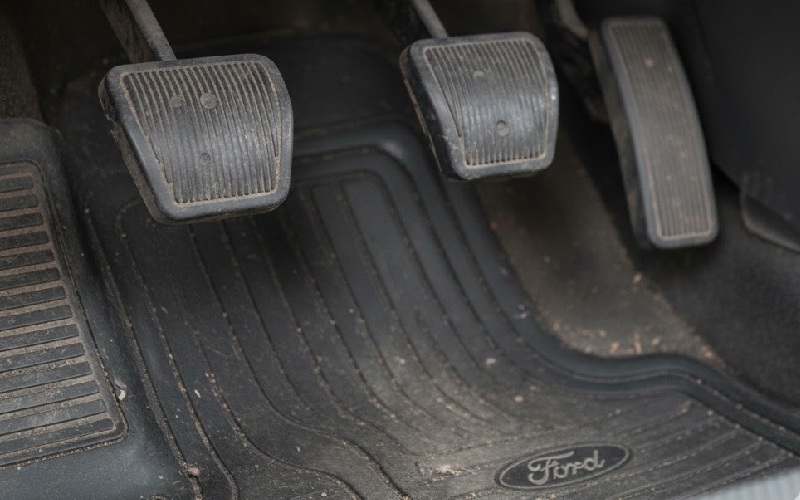Used Car Pedals: The Hidden Story They Tell Buyers
When examining a used car, savvy shoppers look beyond the gleaming paint and polished wheels to find the truth about its history. While odometer readings and service records provide valuable information, the pedals tell a more honest story about how a vehicle has been treated. These unassuming components serve as silent witnesses to a car’s […]
When examining a used car, savvy shoppers look beyond the gleaming paint and polished wheels to find the truth about its history. While odometer readings and service records provide valuable information, the pedals tell a more honest story about how a vehicle has been treated. These unassuming components serve as silent witnesses to a car’s past, often revealing insights that sellers might prefer to conceal. Learning to read the subtle clues offered by brake, accelerator, and clutch pedals can help you make a more informed purchasing decision and potentially avoid costly surprises.

The Truth Behind Pedal Wear on a Used Car
Vehicle pedals experience constant contact throughout a car’s life, making them excellent indicators of actual usage patterns and mileage.
Natural Wear Patterns
Even with careful use, pedals develop distinctive wear patterns over time:
- Brake pedal: Typically shows wear on the upper right portion where the driver’s foot naturally applies pressure
- Accelerator pedal: Often displays wear across the right edge and center
- Clutch pedal (in manual transmission vehicles): Shows concentrated wear on the center and upper portion
These patterns should logically correspond to the vehicle’s reported age and odometer reading. A two-year-old used car with 30,000 kilometers should display minimal pedal wear, while a ten-year-old vehicle with 200,000 kilometers naturally shows more significant signs of use.
Inconsistent Wear Signals
When pedal condition contradicts other indicators of vehicle age and usage, it may signal potential concerns:
- Excessive wear on a low-mileage vehicle suggests possible odometer tampering
- Recently replaced pedals on an older vehicle might indicate an attempt to hide true usage
- Uneven or unusual wear patterns could reveal poor driving habits that impact vehicle condition
- Inconsistent wear between pedals (heavily worn brake but like-new accelerator) may indicate replacement of individual components
These inconsistencies warrant further investigation before proceeding with a purchase.
Brake Pedal Analysis on a Used Car
The brake pedal on a used car often provides the most revealing insights into a vehicle’s history and condition.
Rubber Cover Condition
Most brake pedals feature a rubber cover designed for grip and comfort:
- Smooth, shiny surface: Indicates extensive use, potentially beyond what the odometer suggests
- Worn-through areas: Reveals concentrated pressure points that might indicate aggressive driving
- Cracked or hardened rubber: Suggests exposure to extreme temperatures or advanced age
- Edge wear patterns: Can reveal driver habits such as riding the brake or frequent emergency stops
The material condition should align with the vehicle’s documented age and mileage. Excessive wear on a supposedly low-mileage vehicle requires explanation.
Pedal Height and Feel
Beyond visual inspection, how the brake pedal behaves provides valuable information:
- Pedal height: Should maintain a consistent position relative to other pedals
- Pedal travel: Excessive travel before engaging brakes may indicate worn brake components
- Resistance consistency: Should provide firm, progressive resistance throughout pedal travel
- Return speed: Should return quickly when released, without sticking or lagging
A brake pedal that feels “soft” or “spongy” often indicates air in the hydraulic system, worn brake pads, or potential master cylinder issues—all of which can be costly repairs.
Accelerator Pedal Insights
The accelerator pedal reveals different but equally important aspects of a vehicle’s history.
Wear Location Analysis
Where wear appears on an accelerator pedal tells a story about driving style:
- Concentrated wear at the top: Suggests a driver who frequently drove at high speeds
- Even wear across the surface: Indicates more moderate, varied driving habits
- Right edge wear: Common in vehicles driven primarily in city conditions with frequent stop-and-go traffic
- Minimal overall wear: Either indicates low actual mileage or recent pedal replacement
Heavy, concentrated wear points often correlate with more aggressive driving habits that may have placed additional stress on the engine and transmission.
Electronic Accelerator Considerations
Modern used cars use electronic throttle controls rather than mechanical linkages:
- These systems typically show less physical wear than older mechanical versions
- Even with electronic systems, the pedal cover and housing should show age-appropriate wear
- Recently replaced electronic accelerator pedals might indicate past electrical issues
- Pedal responsiveness should be smooth and consistent throughout its range of motion
Any hesitation, sticking, or inconsistent response warrants professional evaluation before purchase.
Clutch Pedal Revelations (Manual Transmissions)
For used cars with manual transmissions, the clutch pedal offers perhaps the most valuable insights into both vehicle condition and previous driving habits.
Wear Pattern Interpretation
The clutch pedal’s wear tells a detailed story:
- Heavy wear concentrated at the top: Indicates a driver who frequently “rode” the clutch, suggesting potential clutch system damage
- Smooth, polished appearance: Shows extensive use that should correlate with the odometer reading
- Wear on the side edges: Often indicates aggressive driving with frequent, rapid clutch engagement
- Uneven surface wear: May suggest improper clutch technique that could have damaged the transmission
These patterns help assess not just how much the vehicle was driven, but also how well it was driven—information directly relevant to the condition of the transmission and clutch system.
Clutch Feel Assessment
How the clutch pedal operates provides immediate feedback about the clutch system’s condition:
- Engagement point: Should occur at a logical point in the pedal travel (typically mid-way)
- Pedal resistance: Should be firm but not excessively heavy
- Return action: Should be smooth and consistent
- Vibration or pulsation: May indicate worn components in the clutch system
A clutch that engages very high in the pedal travel often indicates significant wear, potentially requiring expensive replacement soon after purchase.
Additional Pedal Area Clues
The areas surrounding the pedals on a used car contain further evidence of a vehicle’s history and condition.
Floor Mat Condition
Floor mats provide supplementary evidence about vehicle use:
- Wear patterns: Should match the pedal wear and align with reported mileage
- Material condition: Severe deterioration might indicate exposure to harsh elements
- Replacement mats: New mats paired with heavily worn pedals may suggest an attempt to disguise high usage
- Staining or damage: Can indicate fluid leaks or water intrusion issues
The floor mat condition should tell the same story as the pedals themselves—significant contradictions merit further investigation.
Surrounding Trim Inspection
The trim and surfaces around the pedals offer additional insights:
- Scuff marks: Heavy marking on surrounding surfaces suggests intense use
- Plastic condition: Fading, cracking, or excessive wear indicates either high mileage or poor maintenance
- Fastener condition: Worn or missing fasteners might indicate previous repair work
- Fluid stains: Discoloration near the pedals could reveal brake fluid leaks or other hydraulic issues
These areas receive less attention during pre-sale cleaning, often preserving evidence that might otherwise be concealed.
Comparison with Overall Vehicle Condition
Pedal condition on a used car should be evaluated within the context of the vehicle’s overall presentation.
Consistency Check
Look for logical consistency between pedal wear and other wear indicators:
- Steering wheel: Wear should align with pedal condition and reported mileage
- Shift knob (particularly in manual transmissions): Should show comparable wear to the clutch pedal
- Driver’s seat: Bolster and cushion wear should correspond with pedal condition
- Interior touch points: Door handles, window switches, and other frequently used controls should display proportional wear
Significant discrepancies between these elements often indicate selective replacement to mask true vehicle condition.
Document Verification
Use pedal condition to help verify documentation:
- Compare wear against service records to confirm maintenance history
- Assess whether pedal condition aligns with reported accident history
- Verify that wear corresponds with the type of use described by the seller
- Consider whether the pedal condition matches the seller’s description of primary drivers
When the physical evidence contradicts the paperwork, the physical evidence usually tells the more accurate story.
What Pedals Reveal About Vehicle History on a Used Car
The pedals in a used vehicle serve as honest chroniclers of its past, often revealing information that might otherwise remain hidden. By knowing what to look for, potential buyers can use these insights to make more informed decisions.
Heavily worn pedals on a supposedly low-mileage vehicle strongly suggest odometer tampering, a serious concern that should prompt reconsideration of the purchase. Conversely, recently replaced pedals on an older vehicle might indicate an attempt to conceal the true usage history.
The specific wear patterns on a used car can reveal how the vehicle was driven—gentle, consistent wear suggests careful operation, while aggressive, concentrated wear points to harder driving that may have placed additional stress on mechanical components.
For manual transmission vehicles, the clutch pedal offers particularly valuable insights, potentially saving buyers from expensive clutch replacement shortly after purchase. A clutch pedal with heavy wear concentrated at its top edge often indicates a driver who habitually “rode” the clutch, a practice that significantly reduces clutch lifespan.
Perhaps most importantly, pedal condition serves as a reality check against seller claims and documentation. When the story told by the pedals contradicts the story told by the seller, prudent buyers listen to the pedals—they rarely lie.
Facts About Vehicle Pedals on a Used Car
- The average driver’s foot makes contact with the brake pedal approximately 300,000 times over 100,000 kilometres of driving, creating a unique wear pattern as distinctive as a fingerprint that forensic experts can use to identify if a specific person was driving a vehicle.
- Modern luxury vehicles often feature pedals made from aluminum alloy with rubber inserts that wear differently than traditional all-rubber pedals, with the metal maintaining its appearance while the rubber inserts show distinctive compression patterns that reveal actual usage.
- Clutch pedals in performance vehicles like the Ford Mustang typically show wear on the left side rather than the center due to the specific foot angle needed for heel-toe downshifting, a technique used by performance driving enthusiasts.
- Vehicle manufacturers design brake pedals approximately 7 centimetres higher than the accelerator pedal to prevent accidental acceleration during emergency situations, making this height difference a useful indicator for detecting accident repairs.
- Temperature fluctuations can significantly affect rubber pedal cover durability, with vehicles operated in regions experiencing extreme cold showing unique cracking patterns perpendicular to the foot pressure direction, while those from hot climates tend to develop parallel stress lines.
Disclaimer: Content contained in this post is for informational purposes only and may include features and options from US or international models. Please contact the dealership for more information or to confirm vehicle, feature availability.


